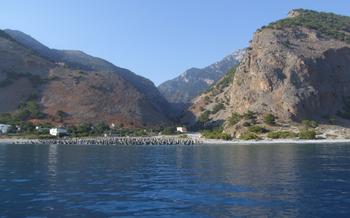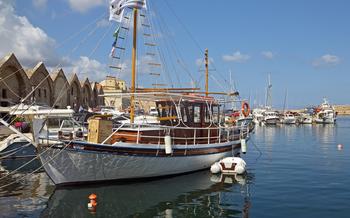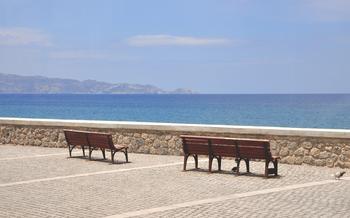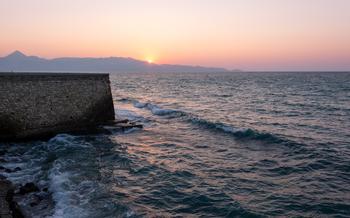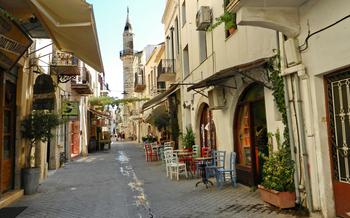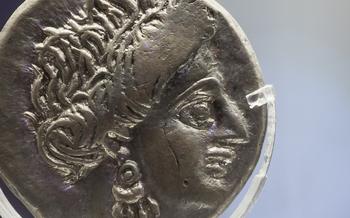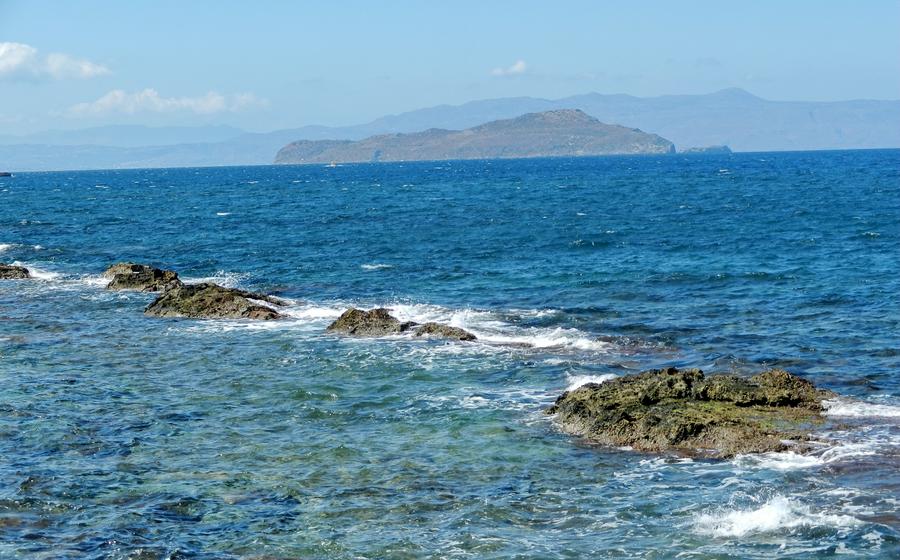
Ancient Lissos
- A Journey to Ancient Lissos: Unveiling Crete's Hidden Gem
- Reaching the Ruins: A Path Through Serenity
- The Walls of Time: Exploring Lissos' Fortified City
- The Sacred Realm: Delving into the Temple of Asclepius
- Whispers of the Past: Unearthing the Roman Baths
- Echoes of Ancient Trade: Exploring the Harbor
- A Culinary Delight: Savoring Traditional Cretan Cuisine
- Embrace the Serenity: Camping Under the Stars
- A Photographic Haven: Capturing the Essence of Lissos
- The Olive Groves: A Testament to Nature's Bounty
- The Village Charm of Sougia: A Welcoming Haven
- The Mythical Minotaur: Exploring the Palace of Knossos
A Journey to Ancient Lissos: Unveiling Crete's Hidden Gem
Nestled along the southwestern coast of Crete, lies the ancient city of Lissos, a hidden gem waiting to be discovered. Once a thriving port town, Lissos played a significant role in Crete's maritime trade and cultural exchange. However, the city's fate took a turn in the 4th century AD when it was abandoned due to a series of devastating earthquakes and Arab raids.
The strategic location of Lissos contributed to its prominence. Situated on a small peninsula, the city enjoyed natural protection from the sea and easy access to trade routes. Its proximity to North Africa and the Peloponnese made it a crucial hub for maritime activities, fostering cultural exchange and economic prosperity.
Lissos' abandonment marked the end of an era, yet its ruins stand as a testament to its former glory. Today, visitors can embark on a journey through time as they explore the remnants of this ancient city, uncovering the secrets of a civilization that once flourished on Crete's rugged coastline.
Reaching the Ruins: A Path Through Serenity
Reaching Lissos from Chania is a journey that unveils the tranquility of Crete's countryside. Immerse yourself in the picturesque village of Sougia, a charming haven nestled along the southern coast. From here, embark on an alluring walking trail that winds its way through serene landscapes, offering breathtaking views of the Libyan Sea. The well-maintained path, suitable for hikers of all levels, invites you to embrace the serenity of nature as you make your way towards the ancient ruins. Along the way, relish the sweet fragrance of wildflowers and the symphony of birdsong that accompany your steps.
The Walls of Time: Exploring Lissos' Fortified City
As you step through the ancient gateway, the imposing walls of Lissos rise before you, a testament to the city's resilience and strategic importance. These formidable fortifications once served as a protective barrier, safeguarding the inhabitants from external threats. Constructed with precision and strength, the walls feature several well-preserved towers and gateways, offering a glimpse into the city's architectural prowess.
Strolling along the fortified perimeter, you'll discover intricate details that speak to the skill and artistry of the ancient builders. The walls, constructed using local stone, seamlessly blend into the surrounding landscape, creating a harmonious fusion of nature and human ingenuity. As you explore further, you'll notice strategic vantage points, cleverly positioned to provide a panoramic view of the surrounding terrain, allowing the city's defenders to keep a watchful eye on approaching enemies.
The fortifications of Lissos not only provided protection but also served as a symbol of the city's power and prosperity. By showcasing their defensive capabilities, the people of Lissos conveyed a clear message to potential adversaries: this city was not to be trifled with. These fortifications stand as a testament to the resilience and ingenuity of the ancient Lissos, a city that thrived on its strategic location and its ability to withstand the challenges of time.
The Sacred Realm: Delving into the Temple of Asclepius
Nestled amidst the ruins of Lissos, the Temple of Asclepius stands as a testament to the town's deep religious beliefs. Dedicated to the revered Greek god of healing, Asclepius, this sacred site once served as a sanctuary for those seeking relief from ailments and maladies.
As you approach the temple, the remnants of its grand structure evoke a sense of awe and reverence. Explore the architectural remnants, including the foundations, columns, and intricate carvings that adorn the site. These remnants offer a glimpse into the architectural prowess of the ancient Lissos people.
Beyond its physical remains, the Temple of Asclepius holds profound significance as a center of religious practices in ancient Lissos. Devotees would flock to the temple seeking divine healing and guidance. Imagine the atmosphere of reverence and hope that permeated this sacred space as people sought solace and rejuvenation.
Discover the intricate details of religious rituals and practices that took place within the temple walls. Uncover the secrets of ancient healing methods and the role of the temple priests who served as intermediaries between the divine and the mortal realms.
Whispers of the Past: Unearthing the Roman Baths
Amongst the ruins of Lissos, the Roman baths stand as a testament to the town's once-thriving culture. Built during the Roman period, these well-preserved baths offer a glimpse into the daily lives and customs of the ancient inhabitants. Explore the complex, marveling at the intricate mosaic floors that adorn the bathing chambers. These mosaics depict scenes from mythology and daily life, providing a vibrant glimpse into the artistic traditions of the time.
The baths were an essential part of Roman society, serving not only for hygiene but also as a place for social interaction and relaxation. Imagine the bustling atmosphere as locals gathered here to bathe, socialize, and exchange news. The baths' strategic location near the harbor suggests that they may have also been used by weary travelers and traders seeking refreshment after a long journey.
As you wander through the ruins, let your imagination transport you back in time. Picture the bathers immersing themselves in the warm, soothing waters, enjoying the therapeutic benefits of the natural springs. The baths' impressive state of preservation offers a rare opportunity to connect with the daily lives of the ancient Lissans, providing a tangible link to their rich history and culture.
Echoes of Ancient Trade: Exploring the Harbor
As you approach the ruins of Lissos, you will be greeted by the remnants of its ancient harbor. Once a bustling hub of maritime activity, the port played a crucial role in the town's economy and prosperity. The well-preserved harbor structures, including the breakwater and the harbor walls, offer a glimpse into the vibrant trading networks that connected Lissos with other Mediterranean ports.
Imagine the hustle and bustle of ancient merchants, sailors, and fishermen as they loaded and unloaded their goods onto the waiting ships. The air would have been filled with the sounds of haggling, laughter, and the creaking of ships' rigging. Lissos' strategic location at the crossroads of major sea routes made it a thriving center of commerce, where goods from all over the Mediterranean were exchanged.
As you explore the harbor ruins, you can almost picture the ancient ships arriving from distant lands, laden with exotic spices, fine pottery, and precious metals. These goods would have been traded for local products such as olive oil, wine, and wool, which were renowned for their high quality. The harbor was also a vital link to the mainland, allowing Lissos to maintain strong cultural and economic ties with the rest of Greece.
Today, the harbor stands as a testament to the ingenuity and maritime prowess of the ancient Lissans. Its ruins serve as a reminder of the town's former glory and the important role it played in the maritime trade networks of the ancient world.
A Culinary Delight: Savoring Traditional Cretan Cuisine
Lissos may be a sanctuary of ancient history, but it's also a place where you can indulge in the delectable flavors of traditional Cretan cuisine. As you explore the area, take advantage of the opportunity to savor the region's culinary treasures.
Nestled amidst the picturesque surroundings of Lissos, you'll find several tavernas and restaurants that offer a taste of authentic Cretan dishes. Prepared with fresh, locally sourced ingredients, these culinary delights are sure to tantalize your taste buds.
Start your culinary journey with a traditional Greek salad, featuring ripe tomatoes, crisp cucumbers, and tangy feta cheese, drizzled with a rich olive oil dressing. For a taste of the sea, try the freshly caught fish, grilled to perfection and seasoned with aromatic herbs.
Don't miss the chance to sample the local specialty, "dakos," a traditional barley rusk topped with ripe tomatoes, crumbled feta, and a drizzle of olive oil. This simple yet flavorful dish is a testament to the region's culinary heritage.
As you savor these culinary delights, you'll also experience the warmth of Cretan hospitality. The tavernas are often family-run, and you'll be welcomed with open arms and treated to a memorable dining experience.
So, as you explore the ancient ruins of Lissos, don't forget to indulge in the culinary treasures that the region has to offer. From fresh seafood to traditional dishes bursting with local flavors, a culinary adventure awaits you in Lissos.
Embrace the Serenity: Camping Under the Stars
As the sun sets over the ancient ruins, the magic of Lissos unfolds under the vast expanse of the night sky. Embrace the serenity of camping amidst the historical treasures, where tranquility reigns and the stars twinkle like diamonds. Designated camping areas provide a haven for travelers seeking a unique and immersive experience. Pitch your tent and let the sounds of nature lull you to sleep, while the gentle sea breeze whispers secrets of the past. Gaze upon the starlit sky, where constellations dance in harmony, creating a celestial spectacle that will leave you breathless. In the morning, awaken to the sound of birdsong and the refreshing scent of the sea, ready to embark on another day of exploration in this enchanting realm.
A Photographic Haven: Capturing the Essence of Lissos
Lissos presents a picturesque canvas, inviting photography enthusiasts to capture its timeless beauty. The ancient ruins, set against the backdrop of the sparkling sea, create a harmonious composition that begs to be immortalized. Explore the diverse landscapes, from the rugged cliffs to the sandy coves, to discover unique perspectives and stunning shots. Let your lens capture the essence of ancient Lissos, preserving its charm and allure for generations to come.
The Olive Groves: A Testament to Nature's Bounty
As you venture beyond the ancient ruins of Lissos, you will be greeted by a verdant tapestry of olive groves, a testament to the region's rich agricultural heritage. These groves, with their gnarled trunks and silvery-green leaves, have stood for centuries, their roots deeply entwined with the history and culture of Crete.
Take a leisurely stroll amidst these majestic trees, marveling at their resilience and the abundance they provide. Learn about the intricate process of olive cultivation, from the careful pruning of branches to the harvesting of the precious fruit. Discover the secrets behind the production of the region's renowned olive oil, a liquid gold that has been cherished for its flavor and health benefits since ancient times.
Sample the local olive oil, savoring its distinct aroma and peppery taste. Indulge in culinary delights infused with this liquid treasure, from freshly baked bread and succulent grilled meats to traditional Cretan salads bursting with flavor. Let the flavors of Crete linger on your palate, a reminder of the region's culinary heritage and the bounty of nature that surrounds you.
The Village Charm of Sougia: A Welcoming Haven
Nestled between the imposing mountains and the azure waters of the Libyan Sea, the picturesque village of Sougia beckons travelers with its irresistible charm. As you approach, the village's whitewashed houses, adorned with colorful bougainvillea, create a striking contrast against the backdrop of the rugged landscape. Take a leisurely stroll through the narrow, cobblestone streets and discover hidden corners that exude the essence of traditional Cretan life.
The heart of Sougia revolves around its pristine beach, a haven for sun-seekers and water enthusiasts. Sink your toes into the soft, golden sand and bask in the warm embrace of the sun. Dive into the crystal-clear waters and explore the vibrant marine life that inhabits the underwater world. For a truly rejuvenating experience, indulge in a massage on the beach, allowing the gentle sound of the waves to lull you into a state of tranquility.
As the sun begins to set, the village transforms into a vibrant hub of activity. The tavernas along the waterfront come alive with the sounds of laughter and chatter as locals and visitors gather to savor the delectable flavors of traditional Cretan cuisine. Indulge in freshly caught seafood, succulent grilled meats, and a variety of mouthwatering meze dishes, all accompanied by the warmth of Cretan hospitality.
Whether you seek relaxation, adventure, or a glimpse into the authentic Cretan way of life, the village of Sougia offers an unforgettable experience. Let its charm captivate you as you immerse yourself in the beauty and tranquility of this hidden gem.
The Mythical Minotaur: Exploring the Palace of Knossos
Nestled in the heart of Crete, approximately a two-hour drive from Chania, lies the ancient city of Knossos, home to the legendary Palace of Knossos. This awe-inspiring palace, once the grand seat of King Minos, is considered the ceremonial and political center of the powerful Minoan civilization that flourished on Crete from around 2700 to 1450 BC.
Step into the realm of myth and legend as you wander through the remarkably preserved ruins of this sprawling palace complex. Marvel at the intricate frescoes adorning the walls, depicting scenes of daily life, religious rituals, and mythical creatures. Among these captivating murals, the enigmatic image of the Minotaur, a mythical beast with a human body and a bull's head, stands out.
Discover the captivating stories and legends surrounding the Minotaur and its labyrinthine lair within the palace. According to Greek mythology, King Minos imprisoned the fearsome creature in a complex maze designed by the renowned craftsman Daedalus. Each year, seven young men and seven maidens were sacrificed to appease the Minotaur until the arrival of Theseus, a courageous hero who, with the help of Ariadne, Minos' daughter, navigated the labyrinth and slew the beast.
Exploring the Palace of Knossos is an unforgettable journey through time, where history, myth, and legend intertwine. Let your imagination soar as you wander through the grand halls, courtyards, and chambers, envisioning the grandeur and opulence of this ancient civilization.
